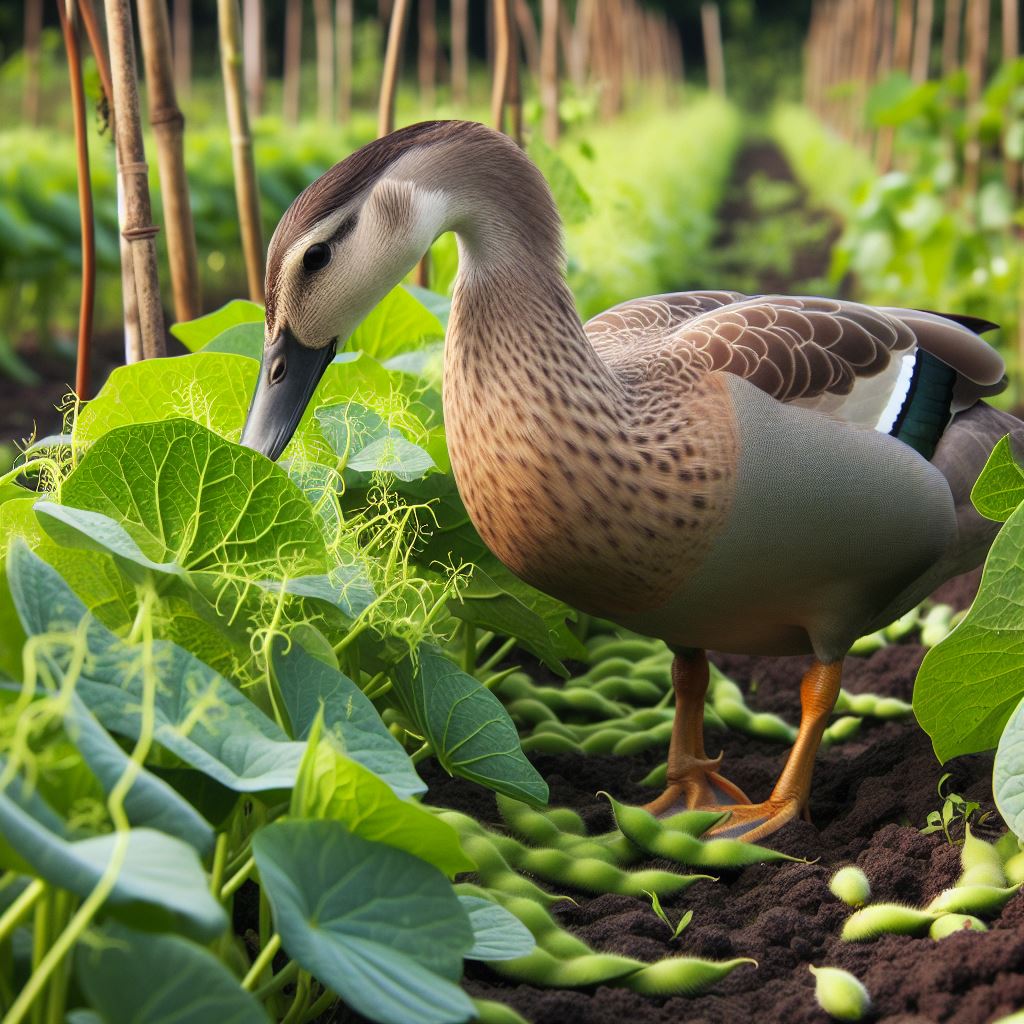Do Ducks Eat Tadpoles? Tadpoles as Potential Prey

Table of content:
Ducks are a common sight around ponds, lakes, and other waterways. These web-footed waterfowl can be seen dabbling in the water, filtering food sources through their beaks. Ducks have a diverse, omnivorous diet consisting of aquatic plants, insects, fish, frogs, and more. But do ducks also eat tadpoles? Let’s take a closer look at the predator-prey relationship between ducks and tadpoles.
Ducks as Aquatic Predators
Ducks belong to the family Anatidae, which includes swans, geese, and other waterfowl. There are around 140 species of ducks worldwide. Most live on freshwater lakes and marshes, with some inhabiting seashores and estuaries.
Ducks are opportunistic feeders. They consume a varied diet based on the food sources available in their habitat. A duck’s bill is a specialized filtering tool that allows it to sift through mud and water for food.
Here are some of the main items in a duck’s diet:
- Plants – Ducks eat aquatic plants like pondweeds, wild celery, and algae. They will also graze on grasses and other vegetation along the water’s edge.
- Insects – Ducks will eat aquatic insects like mosquitoes, mayflies, and water beetles.
- Mollusks – They consume snails, slugs, freshwater mussels and clams.
- Fish – Small fish like minnows may be preyed upon by ducks.
- Frogs & Tadpoles – Ducks will eat adult frogs and frog eggs/tadpoles when the opportunity arises.
- Crustaceans – Ducks will eat small crustaceans like crayfish, shrimp, and aquatic sowbugs.
- Seeds & Grains – Ducks supplement their diet with grains, cereals, rice, and seeds.
Ducks sometimes even eat small reptiles, mammals, and leeches as part of their varied diet. Their ability to capture and consume so many types of aquatic prey makes them formidable predators.
Tadpoles – Vulnerable Prey for Ducks
Tadpoles are the juvenile life stage of frogs and toads. After hatching from eggs, tadpoles live an entirely aquatic existence as they develop and grow.
A tadpole’s body is specially adapted for life underwater. They have a long finned tail for swimming, gills for breathing, and lack limbs. Their diet consists of algae and debris filtered from the water.
Tadpoles are very vulnerable to predation because they lack defenses. Their soft bodies make them easy picking for predators. They have poor mobility on land and cannot escape except by swimming away. And tadpoles often exist in large groups, making them an abundant food source.
Common tadpole predators include fish, birds, turtles, snakes, insects, and even other amphibians. Basically anything that shares their aquatic habitat. Predators help keep tadpole populations in balance with their ecosystem.
Do Mallard Ducks Feast on Tadpoles?
The mallard (Anas platyrhynchos) is one of the most ubiquitous and recognizable duck species. These “dabbling ducks” live in wetlands throughout North America.
Mallards are omnivorous and opportunistic foragers. They will eat pretty much anything – plants, insects, fish, or other small aquatic animals. Tadpoles certainly fall within their broad diet.
Studies have shown that tadpoles make up a small but consistent part of the mallard diet:
- Research in Texas found that tadpoles made up roughly 5% of the mallard’s annual food consumption.
- In Maine, mallard stomach samples showed tadpoles occurring in 6% of adults and 10% of juvenile mallards.
- A Montana study found mallard ducklings ate tadpoles more frequently than adult ducks – likely an easy protein source for growing ducks.
So while not a primary food source, mallards do regularly feast on tasty tadpoles when the chance arises. Their diving and dabbling makes them dangerous predators for these vulnerable amphibian babies.
Do Ducks and Geese Consume Tadpoles?
Mallards are not the only ducks that eat tadpoles. Many other duck and waterfowl species will opportunistically prey on tadpoles as part of their diet.
For example:
- Wood ducks (Aix sponsa) – A colorful North American duck that commonly eats tadpoles.
- Mandarin duck (Aix galericulata) – A small perching duck from Asia that eats tadpoles.
- American wigeon (Anas americana) – These “dabbling ducks” consume tadpoles among other small aquatic animals.
- Canada geese (Branta canadensis) – Yes, geese eat tadpoles too when the chance arises.
Various breeding and migratory habits influence which ducks and geese consume tadpoles:
- Spring breeders – Mallards, wood ducks, and other ducks that breed early in the northern spring eat more tadpoles because amphibian breeding overlaps.
- Wintering birds – Many ducks and geese migrate south for the winter. They opportunistically eat more tadpoles in warmer southern climates.
- Nesting birds – Female ducks seem to especially target tadpoles when breeding. Easy protein for egg-laying and raising ducklings.
So while omnivorous ducks don’t solely subsist on tadpoles, these defenseless baby frogs do appear often on ducks’ menus during key life stages and migrations.
Comparing Ducks Eating Frogs vs. Tadpoles
Frogs share aquatic habitats with tadpoles, so ducks eat both adults and juveniles. But is one better duck food than the other?
Some key differences:
- Mobility – Tadpoles have weaker swimming abilities than adult frogs. They cannot flee or escape predators as easily.
- Availability – Tadpoles congregate in the thousands during breeding seasons. Frogs are more solitary.
- Size – Tadpoles are much smaller than mature frogs. They are easier for ducks to swallow and digest.
- Defenses – Frogs have stronger legs for jumping away from danger. And their skin secretes distasteful mucus. Tadpoles lack these defenses.
- Nutrition – Weight for weight, tadpoles and adult frogs offer similar nutritional value. But tadpoles take less effort to catch and eat.
So while ducks eat both, tadpoles tend to be easier, abundant prey. Their availability in huge numbers during breeding season makes them an efficient protein supplement for ducks.
Why Do Ducks Eat Tadpoles?
Ducks are omnivores, so tadpoles add diversity to their nutritious diet of both plant and animal foods. Specifically, tadpoles offer ducks several advantages:
- Protein – Tadpoles provide essential amino acids for building duck muscles and tissues. Developing ducklings especially require protein.
- Fat – Tadpoles contain lipids and fatty acids that provide ducks energy.
- Vitamins & minerals – Tadpoles supply important micronutrients like vitamin B12 and selenium.
- Convenience – Tadpoles are small, abundant, and easily caught by dabbling and diving ducks.
- Breeding boost – Tadpole protein and nutrients may help female ducks produce eggs and raise ducklings.
- Population control – Ducks help keep dense tadpole numbers in check, balancing the aquatic ecosystem.
Tadpoles are not a mainstay food item, but ducks opportunistically eat them to supplement their nutritional requirements. These bite-sized, meaty morsels offer ducks an easy to catch, nutritious aquatic snack.
Can Ducks Control Excessive Tadpoles?
Tadpoles hatch in the thousands during breeding seasons. This huge population boom can result in too many tadpoles competing for limited resources. Can feasting ducks help control overabundant tadpole growth?
Ducks do prey on ample tadpole numbers and can inhibit their survival. But some key factors determine whether ducks significantly influence tadpole populations:
- Breeding habitat – Ducks control tadpoles more in small, confined habitats vs. large ponds.
- Tadpole density – With extremely dense tadpole swarms, duck predation has little impact.
- Prey diversity – If ducks have alternative prey choices beyond tadpoles, they eat fewer.
- Duck density – More ducks concentrated around breeding sites leads to greater tadpole predation.
- Weather – Cooler temperatures result in extended tadpole development, increasing duck predation risk.
- Submerged refuges – Hiding places like submerged logs and vegetation help tadpoles evade ducks.
So while ducks prey on many vulnerable tadpoles, their population control effects depend on specific conditions. Only in certain scenarios will ducks significantly curb excessive tadpole numbers.
Do Ducks Help or Harm Tadpole Populations?
Ducks prey on tadpoles, but they may also benefit amphibians in some ways:
- Population control – As mentioned, ducks help curb tadpole overcrowding when resources are scarce.
- Genetic diversity – Selective predation by ducks ensures only the fittest tadpoles survive. This promotes genetic adaptation.
- Nutrient cycling – Ducks excrete waste into the water after eating tadpoles, adding nutrients. This fertilizes aquatic plants that tadpoles eat.
- Habitat dispersal – Duck predation gives incentive for tadpoles to spread out rather than cluster. This prevents stripped resources.
- Breeding advantage – High protein tadpole snacks help ensure healthy duck reproduction. More ducks reinforce natural checks on tadpole population booms.
Moderately preying on vulnerable tadpoles helps maintain balance in the aquatic ecosystem. Like other predators, ducks play an important role in tadpoles’ complex web of life.
Conclusion
Ducks belong to the diverse Anatidae family of waterfowl. As omnivores, they have a varied diet including plants, fish, insects, and other small prey. This certainly includes protein-packed tadpoles.
While not their sole food source, ducks do opportunistically feast on meaty tadpoles during prime breeding seasons. Tadpoles offer ducks easy to catch, nutritious snacks, especially important for breeding and migrating ducks.
Ducks help control inflated tadpole populations through natural predation. And tadpoles contribute to ducks’ dietary nutrition and reproductive health. The predator-prey relationship between ducks and tadpoles is a natural part of their interdependent aquatic ecosystem.
So the answer to “Do ducks eat tadpoles?” is a definite yes. Dabbling duck species like mallards commonly eat these defenseless amphibian babies when they get the chance. It’s an interaction that balances and sustains aquatic habitats.
Welcome. I’m Adreena Shanum, the proud owner of this website, and I am incredibly passionate about animals, especially poultry. I founded adreenapets.com as a labor of love, stemming from my desire to share my knowledge and experiences with poultry enthusiasts worldwide.




